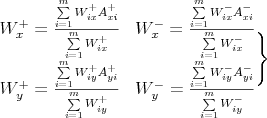The centroid method and the Anger camera
Below, we show how the analytical position estimation algorithm called centroid method, which was described for a 1D position-sensitive detector model in Chapter 2.3.1., can be applied in case of a 2D position-sensitive detector.
Let the surface of the NaI(Tl) scintillation single crystal be covered optimally with a set A consisting of a PMT block (Figures 1. and 2.), which contains n elements (PMTs). Let there be the same “m” number of PMTs arranged symmetrically in all of the quarter-planes defined by the directions (+x,-x) and (+y,-y). The position estimation of a gamma event in the individual quarter-planes is performed as follows. Let the output signals of the PMTs taking part in the position estimation of direction +x be denoted by
- the set A+x = (A+x1, A+x2, ..., A+xm),and let the individual weighting factors belonging to the corresponding signals be denoted by
- W+1x, W+2x, ..., W+mx.
Analogously for the other directions:
- direction -x: A-x = (A-x1, A-x2, ..., A-xm); W-1x, W-2x, ..., W-mx
- direction +y: A+y = (A+y1, A+y2, ..., A+ym); W+1y, W+2y, ..., W+my
- direction –y: A-y = (A-y1, A-y2, ..., A-ym); W-1y, W-2y, ..., W-my
With the aid of equations F4 and F5, with respect to the different directions and based on the PMT subsets A+x, A-x, A+y, A-y, the position estimations can be written as follows:

It is already known that the scintillation light collected by all the PMTs, which is proportional to the energy of the gamma photon, can be obtained by giving the algebraic sum (formula F7) of all the PMTs:

where:

By applying formula F3 for equations F10, ..., F14, an X and Y coordinate based on the centroid method algorithm can be given in the case of a 2D position-sensitive detector:


The physical meaning of normalization by the energy signal E in formulae F6, F16 and F17 and its effects on imaging can be interpreted as follows. It is already known that the scintillation detector yields an energy-dependent signal, thus the values W+x, W+y and W-x, W-y carry not only position information, but also energy information. The position estimated by W+x, W+y and W-x, W-y is true only in the case of a given, known gamma photon energy. In order to obtain the real position information of the energy-independent X, Y coordinates, the division with the value E – normalization – must be carried out, as shown in formulae F6, F16 and F17. This also carries the following physical meaning: the position information – image size – obtained this way for a given detector will be energy-independent – i.e. isotope independent – in the gamma photon energy range of 60 keV ≤ Eγ ≤ 600 keV γ after selecting an appropriate energy window. The basic requirement of this is the following: the energy function E(X,Y) has to be considered constant as a function of position along the surface of the detector, within the applied gamma energy range (see the theoretical basis of the Anger camera, criterion 3).